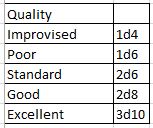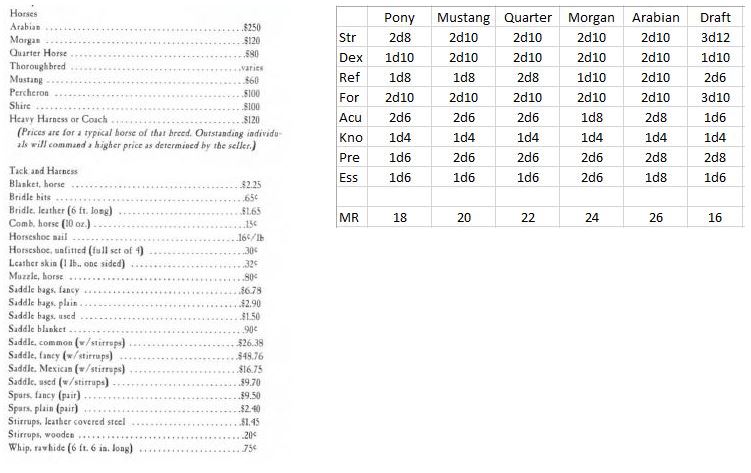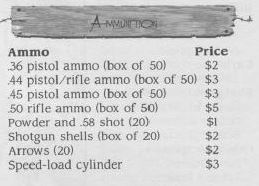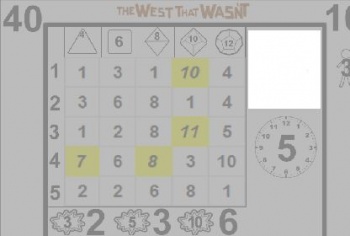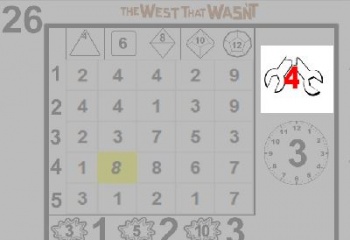TWTW 3.0 - Gear
The following items are available in the West That Wasnt. These lists are not meant to be exhaustive, and many have obviously been stolen from other sources just so we can get the playtesting underway. When this gets into a final state a new gear section will be created.
Contents
[hide]Using Gear
In most cases, to use an item it must be ready. Items are readied by performing an action. Readying an item might include taking a hammer from a toolbox, drawing a sidearm or even un-tethering a horse. Readying the item does not include any movement it takes to get to the item, but it does include any assembly if the item is normally stowed or carried unassembled. Readying an item costs between 1 and 4 APs depending on the size and complexity of the item.
Type Attributes
All items have an attribute that is related to the type of thing it is. For example, a hammer is a tool, and therefore it has the tool attribute. These attributes are not all listed on the gear tables. Usually it is clear if a type attribute applies to a given item, but when it is not, the Judge has the final say.
Gear Lists
The following lists are subject to change, addition, subtraction, and reinterpretation.
Everyday Gear & Tools
Wilderness & Survival
Soldier Boy’s Necessity Kit Walton Inc. is proud to present the SOLDIER BOY’S NECESSITY KIT. “The Kit That Tamed the West!” Includes everything a traveller needs out of doors: nickel plated compass, canteen, flint, and combination reflecting mirror/collapsible cup.
Fulton High-Grade Hatchet Genuine walnut handle, ever-sharp woodsman’s edge. Essential tool for any woodsman or wilderness explorer. For a limited time, Fulton offers a LIFETIME GUARANTEE! Simply mail the broken tool to our manufacturers for a NO-COST replacement.
Wilbert 9-In-1 Utility Knife Never be caught without the right tool again! Wilbert’s 9-in-1 Utility Knife is the CHOICE for the savvy outdoorsman. Includes knife, awl, file, can opener, and more!
Wilbert Hunting Knife Elk-horn handle, with a 7” tempered-steel blade. Comes with a monogrammed leather sheathe (include initials on the provided order form.) Perfect for skinning, carving, and every-day use. Don’t leave your home without one!
Complete Fishing Tackle Outfit Perfect for Novice or Professionals! Includes everything needed for the fisherman: rod, reel, tackle and bob. Teach a man to fish, and he’ll still need Burbank’s Complete Fishing Tackle Outfit!
Victor Jawed Game Trap No.(s) 1-9 From muskrats to bears, Victor’s Jawed Game Trap provides the hunter a clean, reliable catch. Spread of tempered-steel jaws between 3½” to 10½“. “The Trapper’s Choice!”
Burbank Animal Scents Burbank’s Patented Castor-Oil Solution can be used to lure everything from beavers to coyotes, or to mask a hunter’s scent. Works on all manner of animals, predator or prey.
Complete Camping Outfit Survive and thrive in the great outdoors! The Complete Camping Outfit has everything you need to feel at home wherever you are. Comes with bedroll, mess-kit, and oiled canvas tarpaulin.
Fulton Brand “A” Tent High-grade duck cloth tent. Withstands even the worst weather. Standard A-Frame tent includes stakes, poles, and line. “I don’t know what I did before I owned a Fulton Brand tent!”
Pure Manilla Rope Pure Manilla ¾” Rope! Made from durable jute, will withstand all manner of use.
Michigan Cast-Knee Sled Haul anything and everything through winter’s worst with a Michigan Cast-Knee Sled! Reinforced steel-frame runners stand up to the toughest use, even in the coldest weather.
Snowshoes Comfortable and durable-- a must for winter! Sturdy wooden frame and high-quality gut webbing. Never again find yourself out in the cold! Buy Woolver’s snowshoes today!
Comfort, Society, & Luxuries
Religious Articles of High Quality Our collection of religious articles includes crucifixes, rosaries, religious medallions, and statues of Jesus and the Sacred Heart of Mary. All items are of the highest quality, with your option of gold, silver, or nickel-plated. Shipped in silk-lined box (shipping weight may vary.)
Nickel-Plated Pocket Watch Dependable timepieces priced low! Watches made from the most representative names in America. Jeweled imported movement with the maker’s name and guarantee plainly stamped on the interior of each case. Monogram extra (include desired initials with purchase order.)
Knickerbocker Brand Billiard Set Play the right way, with Knickerbocker Brand! Full set includes precision milled ivory billiard balls, and two twine-grip billiard cues. Cues can be purchased separately (see ENTERTAINING section in our catalogue.)
Recruit Brand Playing Cards Linen-finish playing cards. EXTRA quality, air cushioned cards with full-color prints. Delivered in cardboard case. Shipping weight 5 oz.
Dice Cup (With Dice) Leather dice cup with five (5) ½” ivory-colored celluloid dice. Perfect for any number of dice games. Good enough for the most critical of players.
Candies & Confections Popular sized box of the FINEST quality confectionary. Hard candies, pillows, tablets, and patties. Indicate preferred flavors on order sheet: peppermint, mint-and-lemon, barley sugar, horehound, butterscotch, or patented Mentholated Drops.
Bone Handled Tooth Brush Clean Teeth Seldom Decay! Four rows of very fine bristles, securely fastened and closely set. Heavy bone handle in our most popular style, also available in transparent celluloid.
Pebeco Tooth Cream Antiseptic, effective tooth cleanser, made according to the formula of N.S. Jenkins, D.D.S. Free from grit and perfectly harmless to the enamel. Leaves a refreshing aftertaste, with the proper mint flavor!
Williams’ Lilac Soap Three-flower odor from the FINEST French purveyors! Also available in Carnation, Violet, and Witch Hazel. We suggest you purchase a good supply, as soap improves with age!
Hard Rubber Comb Made of polished Hard Rubber with a Bright Finish. Coarse and fine teeth, easily cleaned. Our best pocket comb (also available in Ivory Celluloid.) “A Handy Comb!”
Tools & Utility
Mining Pickaxe Genuine walnut handle, standard-fit iron head. Perfect for the Prospector, Coal-Miner, or General Laborer. “Never Settle for Less than Standard!”
DuPont Company Dynamite General use solid explosive. For excavation or construction. A Miner’s Best Friend! Available in single 3 oz. stick, or bulk-order (inquire for price.) Shipped from a local supplier.
15 Gal. Barrel of Kerosine For Lamps, Engines, or General Use. Finest in quality, utmost in clarity. Also sold in single gallon measures, or 1 pint flasks.
Engine Oil Prolong the life of your engine! Suitable for use in any machine, found in every machinist’s toolbelt. Made from only the finest mineral spirits.
Acme American-Wrought Anvil (“Rings like a Bell!”) Anvil face and horn are solid untempered steel. Body, cast iron. Correct in Temper, Design, and Finish. High Grade in Quality, Material, and Workmanship. Guaranteed to be satisfactory.
Heller Bros. Blacksmith Tools Everything the Professional Blacksmith Needs! Set includes hammer, tongs, rasp, and chisel. All tools made of forged steel, to withstand even the most vigorous use. Tools can be sold separately ($1.09 and up.)
Quick-Cut Grindstone Keep your edges honed with the Quick-Cut Grindstone! Pedal operated, cast-iron frame, fine-grained grindstone. Save money, time, and tools with the Quick Cut Grindstone!
Fulton Standard Bolt-Cutters Cast-iron handles, tempered steel jaw. Forgot your key? Not a problem, with Fulton’s Bolt-Cutters!
6-Lever Padlock The gold-standard of security! Comes with two keys, and a solid brass body. Possessions guaranteed secure, or your money back!
Universal Combination Lock The Worst have tried their Best to crack the NEW Universal Combination Lock! No keys needed.
Victor Carpenter’s Outfit (All Tools) Everything a Carpenter Needs in a Convenient American Walnut Tool Case. Includes the full range of Drills & Drill Bits, Hand-Saws, and Hammers. All tools can be sold separately.
Lion Brand Butcher’s Tools (For Trade and Household Use) Sharp as a Lion’s Claws! Full set includes all knives, hooks, and sundries necessary to prepare game or livestock. All tools can be sold separately.
Barber’s Supplies (incl. Razors, Strops, & Tonics) Everything necessary to a Modern Hygiene Specialist! Includes all antiseptic tonics in sturdy bottles, pearl-handled razor & strop, scissors, and comb. Replacement tonics provided at cost with proof of purchase.
Transportation
High-Quality Horse Feed (With Molasses) Composed of alfalfa, cracked corn, crushed oats, barley, and molasses. Produces fat and muscle, promotes vitality, strength, and staying power.
Low-Quality Horse Feed Good Enough to Eat! Includes grains, leaves, stalks, etc.
“Positive Fit” Ready-To-Wear Horseshoes Get back in the saddle with the Positive Fit! Horseshoes available in all sizes, work well for all breeds.
Red-Bluff Cowboy Saddle A Very Popular Saddle! Western-style, trimmed in rawhide and lined with lambskin. Nickel-plated buckles, leather-lined and leather-capped stirrups.
Navajo Saddle Blanket Genuine hand-woven Navajo Indian Saddle Blankets. All wool, strongly woven, and will give years of useful service. No two blankets exactly alike!
Tool Quality
Equipment is rated in quality from improvised to excellent. Improvised gear is equipment that has been made haphazardly or is being used in a way that it is not intended. For example, a rock or a stick may be used as a hammer, or even a shovel. They will work in a pinch, but are not good at the job. Poor quality tools are either old and worn out, or just shoddily made. The majority of tools are standard quality. Some items are of good quality, in general these cost 2-4x the listed price and are not available everywhere. The best items available are excellent quality, those produced by the finest craftsmen. They cost 10x the listed price.
Not all tools have the higher quality versions available. The simplest tools, such as hammers and shovels, can only be so good. Even the best versions do not produce better results, but instead are sturdier and last longer. Consult the Judge on whether a particular tool has higher quality options, and if they do, whether those items offer the increased efficacy, or only greater durability.
Mounts
A trusty mount is more than just great breeding and increased speed. Mounts can also be trained. The listed prices are for average specimens without training except being saddle broken. Horses can learn the skills training and bravery, both are Essence based.
Training
Training allows a horse to perform basic tasks and tricks, such as coming when called. It can also be used in combat to stomp enemies. When used in combat, the trait is Strength.
Horses learn training via the Animal Care or Cowboy skills. The practice increment is 8 weeks minus the value of the Knowledge trait. The training period must be at least one practice increment per level attempted (level 2 requires 2 increments, level 3 requires 3, etc.). At the conclusion of the training period, the cowboy makes a skill check with a TN of 3 + (new Training level x2). If it is successful, the horse can upgrade their training to the new level.
Bravery
Bravery is the ability of the mount to remain steadfast in the face of fear and terror. It is also the ability to stay calm when the bullets start flying. Bravery can be learned in the same way as training, and it can also be gained via experience.
A horse must test Bravery when their rider is the target of a gunshot, or when they are. The test is TN 4. Failure causes the horse to spook and run in a random direction (use the clock face on an Action Card) at maximum speed until the rider can regain control. Horses with Bravery 2 or greater do not need to test unless they are actually hit, or their rider is knocked unconscious or killed.
In the face of Fearsome creatures, horses must test only when the creature uses their Fear as an action (as described in the Fear section of Interacting with the West, Chapter 7). The TN is 3 + (creature's Fear level x2). Failure causes the horse to spook and run away from the danger until their rider (if any) can regain control.
Horses treat humanoid Terrifying creatures the same as Fearsome ones. They are blissfully unaware that the supernatural is an abomination. In the face of a monstrous Terror, mounts make Bravery checks at Judge's discretion.
Weapon Accessories
A speed load cylinder holds six rounds and can swap out quickly. A full 6 rounds can be loaded for 2 AP. Reloading the cylinder is 1 AP for each round (as a normal reload). Speed load cylinders can only be used with top break revolvers.
Hand Weapons
What follows are the most common melee weapons available in the west. Most are also tools of some sort as well.
Pen: The penetration value of the weapon. Impact weapons also have a value after a slash, which is added to the Force value of the attacker when attacking unarmored foes.
DMG: This is the full damage of the weapon, dealt versus unarmored/unprotected foes or on a P result.
RD: This is the reduced damage, dealt on an A result versus armored or protected foes.
Rel: This is the reliability of the weapon.
AP: This is the number of Action Points it takes to use the weapon. This number is added to the AP for the hand to hand attack type chosen.
S: This is the size of the weapon. This number is also the TN to fast draw the weapon.
Ad: This is the advantage factor of the weapon. All weapons have an advantage factor one higher versus unarmed foes.
Attributes: These are the additional attributes the weapon possesses. Attributes are explained in detail below.
Attributes
Deadly Deadly weapons deal one wound per multiple of the victims size.
Impact: Impact attacks deal the first wound in each attack at double the victims size, subsequent wounds at the victims size. Their damage is added directly to the Strength damage of the character.
Throw: Weapon can be thrown. See muscle powered section under ranged weapons for statistics.
Pain: Concussion damage is doubled when determining result from Stun Save.
Fast: Weapons with the fast attribute win initiative based ties versus other weapons.
Fistload: Character counts as armed versus unarmed foes or others using fistloads, unarmed versus others. Weapon deals Strength damage as well as weapon damage.
Impact Versus Deadly Damage
In TWTW there are two types of damage: Impact and deadly. Impact damage is dealt by blunt weapons and bare hands, while deadly damage is dealt by most other weapons, including edged weapons and firearms.
Impact Damage
Most brawling damage is impact, including clubs and improvised weapons that are not sharp (such as a table leg). When dealing impact damage, begin with the damage for the attack type (quick, standard or heavy), then add the DB of the character and the weapon damage. Compare this number to the targets size times two. If the result is less, deal that amount as concussion to the target. If the result is greater, deal one wound and subtract double the targets size from the result. Repeat the previous steps, but do not double the targets size.
Hank Daggett engages in fisticuffs with one of the Perkins brothers. In the first round, he chooses a heavy attack and hits for full damage of 14. Clem Perkins has a size of 6, so he deals one wound and 2 concussion. Looks like that heavy shot to the bread basket broke a rib or two. Had his blow result been 18 or more he would have dealt two wounds.
Because of the doubling of the initial wound, impact damage is much more likely to lead to high concussion damage, and very unlikely to lead to multiple wounds. This is consistent with most unarmed fights or blows with clubs. These results can still be deadly. See the Conflict for more on dealing impact wounds and wound effects.
Deadly Damage
Weapons without the Impact attribute are deadly. Deadly weapons deal one wound per multiple of the targets size. Any excess result after dealing all possible wounds is dealt as concussion.
While Hank dispatches Clem, Dave Perkins engages Cyril with his knife. Unlike Hank, Cyril is not adept at brawling. Dave slashes Cyril for 9, dealing one wound and 3 concussion. Had he dealt 12 or more he would have done two wounds.
Deadly damage is exactly like it sounds: more likely to kill.
Ranged Weapons
All ranged weapons have an Aim value, which is the AP cost of the aim action, as well as a penalty listed for snap fire (SP). The AP required to use the weapon is listed in the S and N columns, with S being the cost of a snap shot and N being the cost of a normal shot. The C column indicates the cost of any cock action, if applicable.
Ranged Weapon Attributes
Ranged weapons come in numerous sizes and shapes, often with differing performance based on the attributes of the weapon. What follows are three types of attributes: shot, action and other. Shot attributes discuss how projectiles are delivered, propelled and contained. Action describes how the weapon is operated mechanically. Other attributes discuss anything else about the weapon that is noteworthy in game play.
Shot Attributes
Cartridge: Cartridges are self contained bullet and powder in a single unit. Loading most cartridge weapons is a 1 AP action for each cartridge and speed loading is possible. Single action pistols cost 2 AP to start reloading unless they have the Top Break attribute. Some cartridge rifles also have longer reload speeds, and are notated in the attributes.
Muzzle Loader: Muzzle loading weapons require loose powder, ball and percussion cap. Muzzle loading a shotgun is a 10 AP action. If the weapon has multiple barrels, an attempt may be made to load both simultaneously. This requires a coordination check at TN 6. Success indicates both are loaded, failure indicates neither are loaded, but both will be successfully loaded next round with no check required. On a calamity (C) result, neither barrel is loaded and at least one required item is lost (one shot is spent). Performing a muzzle load on a rifle or musket requires 20 AP to complete. Muzzle loading weapons require 1 AP to cock, which can be performed simultaneously with the loading if desired. Muzzle loading weapons cannot be speed loaded.
Percussion: Cap and ball revolvers require a percussion cap, loose black powder and a lead bullet (ball) to load. Loading a Percussion handgun requires 7 AP. One cylinder can be loaded on a 4 TN coordination check, two cylinders on a 6. The chamber fails to load on a failure, but can be attempted again next round with no penalty. On a C result, the chamber is not loaded and at least one required item is lost (the round is spent).
Action Attributes
Breech Load: Breech loading rifles and shotguns are 2 AP to fire when cocked, but require a 1 AP action to cock. Breech loading rifles can load a single cartridge for 1 AP, and can be speed loaded. Breech loading shotguns can load a single cartridge for 1 AP, and can be speed loaded.
Double Action: Double action revolvers are 1 AP actions to fire, and do not need to be cocked. A 1 AP action may be used to cock a double action revolver, if desired. Double action revolvers suffer one downgrade to all targets beyond close, if not cocked, because of the heavier trigger pull.
Fixed Cylinder: Fixed cylinder revolvers require 2 AP to begin a reload and 2 AP per round thereafter. They can be speed loaded.
Hammerless: Hammerless shotguns do not need to be cocked to fire.
Lever Action: Lever action rifles are 2 AP to fire when cocked. They require a 1 AP action to cock. Lever action rifles require a 2 AP to load the first round, but can load subsequent cartridges for 1 AP each. All but the first cartridge can be speed loaded.
Single Action: Single action revolvers are 1 AP when cocked, and require a 1 AP to cock. Single Action revolvers win initiative based ties versus other firearms.
Top Break: Top Break revolvers have a release latch that allows the barrel to draw down and eject spent cartridges, speeding reload time immensely. Top Break revolvers are 1 AP to reload each chamber, and can be speed loaded.
Trapdoor: Trapdoor rifles are similar to breech loading rifles, but instead of pushing the cartridge into the barrel from behind, it is dropped into the action from above. The trapdoor can be opened and reloaded for 2 AP, and cannot be speed loaded. They require 2 AP to cock.
Other Attributes
2x: Weapons with the 2x attribute may fire both barrels simultaneously. When firing both barrels, add the RD to the DMG on P results, and double the RD on A results.
Accurate: Accurate weapons receive the number in parentheses as upgrades to their shooting result if the shot follows an Aim action (not the initial aim to remove the penalty).
Fan Fire: A single action revolver is capable of fan firing. When using the fan fire action, the speed 1 AP per shot, and the Fan Firing rules apply.
Fistload: The character counts as armed versus unarmed characters or other characters using Fistloads. Otherwise, the character is unarmed.
Inaccurate: The short barrel of this weapon makes it harder to find a target. Normal shots suffer one downgrade.
Lethal: Damage bumps deal one damage die plus 2 each.
Muscle: Weapons with the muscle attribute cost 2 AP to use when ready/loaded, and load/ready for 2 AP. The character adds their DB to any damage done by the weapon.
Pain: Targets of this weapon have one downgrade to their stun save.
Scatter: Weapons with the scatter attribute always produce stray shots (see unintended targets, conflict section). Add one to the number of stray shots per range increment. Also, add one downgrade and decrement the penetration every two range increments. If a target is hit because of this rule, treat P results as A, and A results as D. Unarmored targets are treated as an A result.
Handguns
What follows are some of the most common handguns in use the the west. While this does not cover all of the possible makes and models, a comparable model to just about every common pistol is listed.
Legend
Ammo: The number of shots a fully loaded weapon carries.
Range: The number of paces per range increment.
Pen: Penetration value of the weapon.
DMG: Full damage value of the weapon. This is dealt to unarmored/unprotected foes or on P results.
RD: Reduced damage value. This is dealt to armored/protected foes on an A result.
SP: This is the snap shot penalty (in downgrades) for the weapon.
S: The AP cost of a snap shot.
N: The AP cost of a normal shot.
Aim: The AP cost of an aim action.
C: The AP cost of a cock action.
Size: The size value is the TN to fast draw the weapon, as well as the TN to conceal it.
Rel: The reliability of the weapon. This is compared to the malfunction number when applicable. See below.
Attributes: Any attributes the weapon possesses. See above for full descriptions of the attributes.
.44 Army
The 1860 Colt single action revolver is a common sight throughout the West. Its cap-and-ball action requires each cylinder to be tamped down with an integrated lever ram. With paper cartridges, the reloading time is 6 AP (8 AP for loose powder).
An earlier model of the 1860 Colt, the 1851 uses the same frame with a smaller, lighter cylinder. Its cap-and-ball action requires each cylinder to be tamped down with an integrated lever ram. With paper cartridges, the reloading time is 6 AP (8 AP for loose powder).
.41 Derringer
A favorite of gamblers and miscreants, the Remington “Model 95” is a small, easily concealed muzzle-loading pistol. At only 5”, it fits comfortably in a pocket (or even hidden in a clenched fist). Though its small size provides one upgrade to all Fast Draw attempts, its short barrel is inaccurate and relatively weak, giving the user one downgrade to all normal and aimed shots.
Walker Colt
Accurate and deadly, the Walker Colt is known throughout the West. Its reputation as the most powerful handgun available is well earned (as is its reputation for misfires and malfunctions). Despite its quirks, the Walker Colt is highly prized and quite expensive.
Colt Single Action Army
“The Peacemaker;” “The Gun That Won The West.” Regardless of what you call it, the Colt Single-Action Army is known from Boston to San Diego, and every point between. After its release in 1873, its popularity exploded, with models ranging from the original long-barrelled US Cavalry model, to the shorter barrelled Gunslinger model.
Colt Lightning
The first of Colt’s double-action revolvers, the 1877 Colt Lightning can be cocked and fired with a single swift motion. Though it has a number of models, the .41 (listed here) is popular enough to have earned the nickname “The Thunderer.”
Smith & Wesson Schofield
A reliable, single-action, top-break revolver, the Schofield was the first cartridge revolver adopted by the US Army. Though not as popular as Colt’s Peacemaker, the Schofield is an excellent weapon in its own right.
Smith & Wesson .44 Double Action
Released in 1881, the S&W .44 Double-Action is a strong alternative to the Colt. With more “bang for your buck” (as the saying goes) and a smoother action, this new offering from S&W has sprung up throughout the West.
Rifles
Rifles are probably the most common firearm in the west. Their utility for both hunting and self defense make them extremely valuable.
See the legend under handguns, above.
Winchester Model 1873
Everyone knows the Winchester 1873. Over 700,000 units have been produced since the model’s launch, from rifles to carbines (or even the .45 “Peacemaker”) making the 1873 a strong contender for the most common firearm in the west. Reliable, high-capacity, and (perhaps most importantly) cheap, the 1873 is the weapon of choice for many Westerners.
This lever-action rifle is available in a number of calibers. If a player wishes to purchase the rifle in the pistol caliber, substitute the damage (as well as RD) and penetration values from the pistol cartridge but keep the remaining attributes the same.
Sharps Cavalry
Even after the conclusion of the Civil War, the Sharps Carbine remains a top-shelf cavalry firearm. Its short barrel makes it easy to use on horseback, and the falling block reload has remained relatively unchanged since the introduction of metal cartridges.
Sharps Long Rifle
Deadly, powerful, and precise, the Sharps Long Rifle is popular with hunters and sharpshooters alike. Though it is slow to reload, its accuracy is unmatched. This, combined with newly available telescopic sights, makes the Sharps Long Rifle hard to beat.
Springfield Musket
Millions of Army Surplus muskets have flooded the market since the end of the war. Easy to use and cheap as dirt, the Springfield Musket is a perfect choice for homesteaders or farmers. It is, however, limited to a single shot, making it a weapon of last resort for today’s modern gunslinger.
Springfield Trapdoor
A variant of the Springfield Musket adapted for use with a metallic cartridge. Practical and economical, the trapdoor model is nonetheless still a musket, with many of the same limitations.
Spencer Rifle
The Spencer Lever-Action Rifle, featuring a seven-shot magazine, was seen as a leap forward from the musket. As these things go, however, the Spencer finds itself slowly becoming old-fashioned behind models like the Winchester 1873. Still, it’s a reliable choice, and many a cowpoke relies on their Spencer Rifle.
Henry Rifle
With a revolutionary 16-shot magazine, the .44 caliber Henry Rifle was worth its weight in gold for soldiers in the Civil War. Eclipsed in recent years by the Winchester 1873, it nevertheless maintains its solid reputation, and can be found throughout the West.
Shotguns
All shotguns can be "sawed off" to as low as size 5, if the stock is also removed. The above table assumes 12 gauge. For other gauges, consult the following table and substitute the given values.
Hammerless shotguns became available in 1883.
Muscle Powered Weapons
Equipment Reliability
Every piece of equipment has a reliability (Rel) rating from 1-12, with lower numbers being more durable. The reliability section of the action card is above the clock face in the upper right hand portion of the card.
On most cards, that section is blank, like this one. This means that no action is necessary. All equipment performs as expected. Some cards, however, have a broken wrench with an associated number.
When this symbol appears, compare the reliability of the equipment to the number shown inside the broken wrench (in this case a 4). If the reliability of the equipment is higher than the number shown, the equipment fails. Check the toggle result, on a yes the equipment fails after completing the task, on a no it fails before.
If the equipment has a reliability of 1 an extra step must be taken. Check the heroic die. If it also shows a 1, then a malfunction occurs.
Improvised Usage
All of the above assumes that the equipment is being used as designed. When being used in a rough or unintended way equipment is more likely to fail. For new equipment, add 1 to the rel. For old and/or otherwise abused equipment, add 4. In all other cases add 2. Strange or extremely hazardous usage may bring an extra penalty to the Rel of +1-3 at Judges discretion.
Hank wants to smack an angry cowboy with a shovel. The shovel is in average condition, so the Judge adds 2 to the Rel, bringing it to 3.
Some uses are anticipated if not intended, such as hitting an adversary with the butt of a rifle or the handle of a pistol. These uses add 1 to the Rel unless the weapon is old or decrepit, in which case 2 is added.

